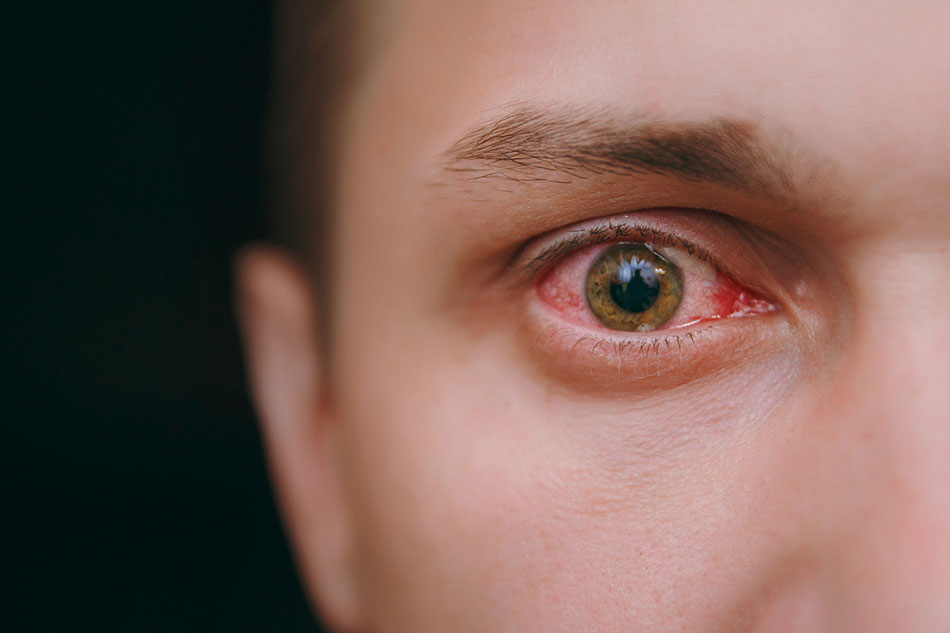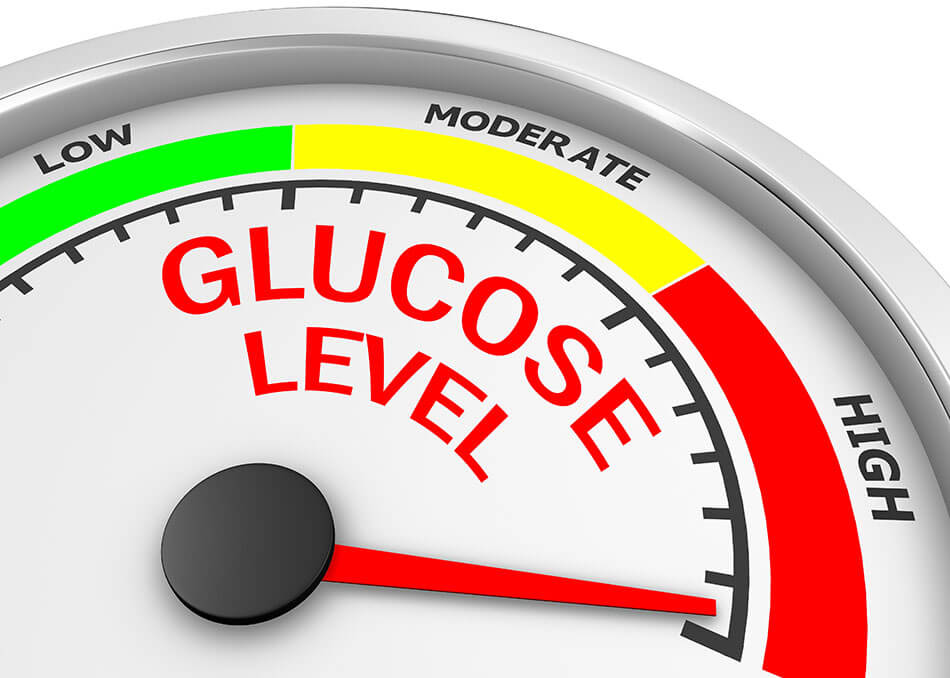Dry Eye Syndrome and 8 of the Top Causes of Eye Redness

Your eyes can become red and bloodshot for perfectly ordinary reasons, such as a lack of sleep or too much time spent staring at a computer screen. It's not pretty, but it's nothing to worry about.
Sometimes, eye redness is a symptom of a common eye condition like dry eye syndrome. While not ideal, this is not a huge cause for concern and is usually treated with eye drops.
Many people experience eye redness because of poor contact lens hygiene. That can be easily rectified by having periodic eye exams and following your eye doctor’s advice. Especially when it comes to keeping your contacts clean.
However, on rare occasions, eye redness is a symptom of a serious health condition and could jeopardize your sight if left untreated.
Let’s examine 8 of the top reasons people suffer from eye redness and irritation. This way, you’ll know what to look out for and how to fix it.
1) Dry Eye Syndrome and Allergies
Dry eye syndrome or dry eye disease occurs when the eyes do not produce enough tears to keep hydrated, or when those tears evaporate too quickly. It’s been reported that 30% of Canadians experience dry eye symptoms.
There are many causes of dry eye. Hormonal changes, environmental factors, and medication side effects to name a few. Poor contact lens hygiene can also contribute. Dry eye syndrome is one of the most common causes of eye redness and can be an indicator of a more serious health problem.
The problem is often caused by allergies. Airborne allergens such as dust, pollen and animal dander are major irritants to the eyes. The physical response from our eyes to contact with allergens is to release natural antihistamines. This is through the creation of tears.
This helpful secretion can flush out allergens, but it also leads to swollen ocular surface blood vessels and unsightly red eyes. Over the counter eye drops can usually treat allergies and settle them down within a few days. However, if symptoms persist, visit your eye doctor.
2) High Blood Sugar and Pressure

High blood sugar associated with diabetes has drastic implications for the health of your eyes. Over time, high blood sugar can clog or damage the blood vessels of the retina, the area at the back of the eye responsible for focusing images.
This weakens the retinal blood vessels and makes them prone to seepage. In response, the eye creates new, abnormally enlarged blood vessels, to replace the faulty ones. Swelling of the tiny blood vessels in the eye and the leakage of blood into the vitreous (the gel-like centre of the eye) makes the eyes appear bloodshot. More worrying, this leakage can stop light from reaching the retina and cause blindness.
High blood pressure, known as hypertensive retinopathy, can have a similar effect on the eyes. Hypertensive retinopathy is marked by enlarged blood-vessels and haemorrhages inside the eye.
High blood sugar and blood pressure diagnoses have become part of a standard eye exam. Early detection is important for successful treatment.
3) Autoimmune Disease
In people with autoimmune disease, the body confuses healthy cells and tissues with unhealthy ones and attacks them. If the eyes appear red, itchy and watery, an eye doctor may see swollen veins on the surface of the eye. An underlying autoimmune disease such as lupus or rheumatoid arthritis could be to blame.
Autoimmune diseases can also compromise the tear ducts which can lead to extremely dry eyes. There are many treatment options for autoimmune diseases but early detection is key to a successful treatment plan.
4) Stress

Stress can trigger many adverse reactions in the body, some of which are visible and some of which are not.
When you’re feeling excessive mental strain, your body can become so worn down that your retina leaks fluid. This condition is Central Serous Chorioretinopathy (CSC). It affects the macula, which is the part of the eye responsible for central vision.
Leaked fluid inside the eye causes redness and inflammation of the blood vessels. The leaked fluid has nowhere to go and can form a blister inside your eye which may need laser treatment.
5) UV Exposure
Too much exposure to ultraviolet light can have a disastrous effect on the eyes. Failing to protect your eyes from the sun raises your risk of developing cataracts, growths in the eye and eye cancer.
UV light can also cause snow blindness, known as photokeratitis. Mild photokeratitis causes eye irritation and a gritty sensation as though something is lodged in the eye.
More severe cases of photokeratitis may cause other symptoms:
- Extreme light sensitivity
- Blepharospasm (spasming of the eyelids)
- Excessive watering
- Blurred vision
- Conjunctival hyperaemia (an inflammation of the blood vessels in the eye)
Visit your eye doctor immediately if you have been exposed to UV light and have these symptoms.
6) Overuse of Eye Drops
If your eyes are dry and itchy, the first advice you’re likely to receive is to give eye drops a try. But when used long-term or applied more often than four times a day, eye drops can cause your eyes to become red and irritated.
This irritation inflames the blood vessels in the eye, which prompts people to use more eye drops. Over the counter eye drops, also referred to as artificial tears, come both with preservatives and without.
The preservatives in eye drops can cause an adverse reaction when used long term. Always be aware of the side effects of eye drops and if your symptoms worsen, discontinue use. It’s time to make an appointment with your eye doctor.
7) Computer Eye Strain

Computer eye strain is one of the most common but benign causes of eye redness. Spending too much time staring at a computer screen exposes your eyes to more blue light than may be healthy.
Staring at screens, such as tablets, phones or computers, causes us to blink less which dries out our eyes. If you are looking at a screen for long periods of time, you’re not alone. An increasing number of Canadians suffer from computer eye strain. This is causing more cases of headaches, dry eyes, blurred vision and neck and shoulder pain.
The best way to limit digital eye strain is to limit the amount of time you spend in front of your computer. Follow the 20-20-20 rule and take a 20-second break every 20 minutes to look 20 metres in front of you.
It’s also important to sit at least an arm’s distance away from your screen. You can increase the size of the text to a comfortable level and reduce overhead lighting to minimize glare.
8) Poor Contact Lens Hygiene

In Canada, 38% of contact lens users don’t comply with lens replacement schedules. Even more report unhealthy habits that could lead to eye pain or redness as a result of poor hygiene.
Contact lenses are medical devices and their use comes with real risks if they are not managed correctly. Failing to clean, disinfect and store contact lenses can cause serious problems. It can introduce dangerous bacteria, viruses and other pathogens into the eye.
Sleeping or swimming in contacts and ignoring lens expiry dates can also irritate the surface of the eye and lead to serious infections. Your contact lens forms a barrier between your eye and the environment which can dry out the eye, starve it of oxygen and incubate bacteria.
If you wear contact lenses and the blood vessels on the surface of your eye become inflamed you should remove your lenses right away. Only once you’ve had the cause of your eye redness diagnosed by an eye care professional should you go back to wearing lenses.
If contact lens hygiene is an issue, you might consider switching to daily disposable lenses. As there is no need to clean, disinfect or store disposable lenses. They are simply thrown away after each use. This minimizes the risk of infection because you are always putting in a fresh new pair of lenses.
Now that you know the top eight causes of eye redness you can better recognize when redness is an inconvenience and when it needs medical attention. Taking steps to improve your eye care and overall health will minimize your risk of developing dry eye syndrome. It will also keep your eyes looking and feeling great.
